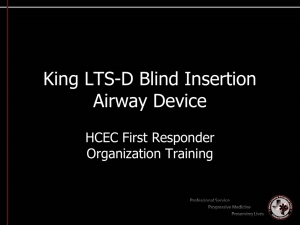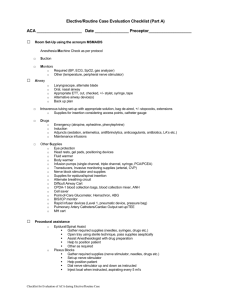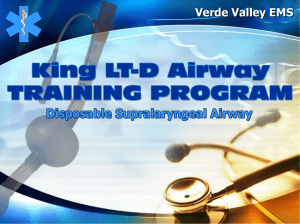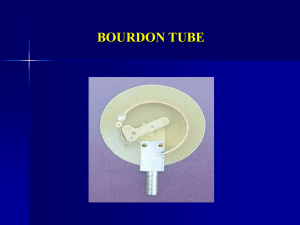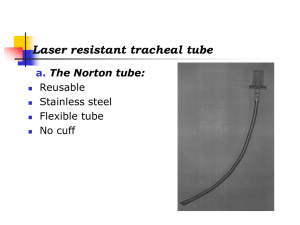King Airway Presentation
advertisement
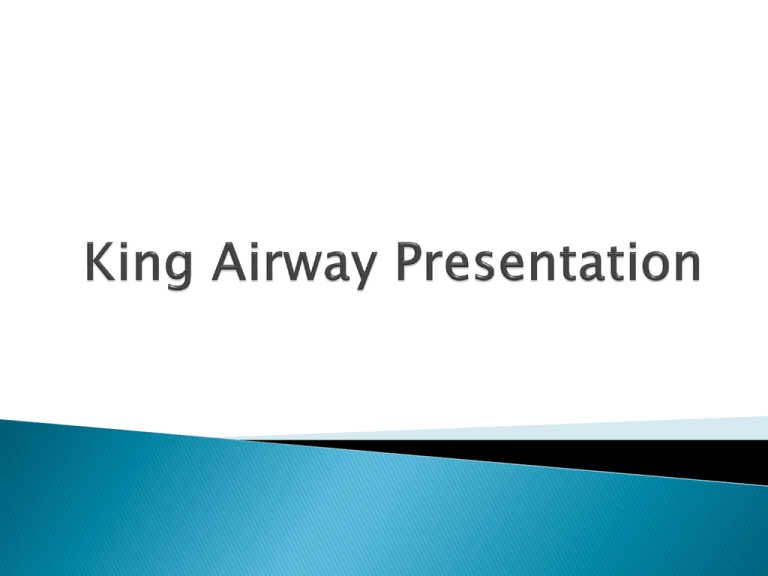
Definition: •The King airway is a single use device intended for airway management. •May be used for EMT’s in the prehospital setting who have been trained in the indications, contraindications, and application of the device. Description •A curved tube with ventilation ports between two inflatable cuffs. •The distal cuff is designed to seal the esophagus. •The proximal cuff is designed to seal the oropharnyx. •At the proximal end of the tube is a 15mm connector to be used with a standard breathing circuit or bag-valve device. Upper airway ◦ ◦ ◦ ◦ Nasopharynx Oropharynx Laryngopharynx Larynx Size selection determined by Patient’s height: •Yellow 4-5 ft •Red 5-6 ft •Purple > 6 ft Indications • To promote airway management by providing a patent airway in the unconscious, apneic patient. • Cardiac arrest. • Respiratory arrest not related to narcotic overdose. • Unable to maintain BLS airway. • The King airway is a latex free product. Contraindications •Responsive patients with an intact gag reflex. •Patients with known esophageal disease. •Patients known or suspected to have ingested caustic substances. Precautions •Vomiting and aspiration. •Excess pressure in the abdomen. Instructions for use: •Choose appropriate size based on patient’s height. •Test cuffs by inflating to recommended volume of air and deflate cuffs completely before attempting to insert. •Generously lubricate tube using a water based lube to prevent from kinking on insertion. •Pre-oxygenate patient with 100% O2. •Have suction ready and available. Insertion: •Position the head in a slightly sniffing position (unless spinal injury is suspected). Then maintain cervical alignment and keep the head in a neutral position. •Insert King Airway rotated 45-90 degrees laterally and insert into mouth. •As you gently advance the tube, rotate the tube to the patient’s midline. •Advance tube until base of connector aligns with teeth or gums. Cuff inflation: •Inflate cuffs with minimum volume necessary to seal the airway according to tube size. •After inflation of cuffs, tube will migrate upwards. This is normal and to be expected. •Attach to resuscitator bag and ventilate using 100% O2 source. •Assure chest rise and fall. Auscultate breath sounds. •Secure tube, note depth of tube placement. Tube placement after insertion and inflation of cuffs: Troubleshooting: •If unable to ventilate with BVM, the tube may be kinked. Deflate cuffs, remove the tube carefully, oxygenate the patient and try again using a new tube if available. Documentation: •In patient care report. •Note time, size and depth of tube placement. •Patient response to procedure to include vital signs, pulse ox, and capnography. REMEMBER! • When placing a King Airway during CPR, minimize interruption of CPR and place tube while CPR is in progress. •If spinal injury is known or suspected, maintain a neutral head alignment and initiate cervical spine precautions concurrently with airway management. Questions? King Airway video presentation: http://www.youtube.com/watch?v=ByHCOwDp1BQ
